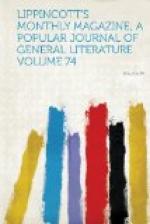We wander through cloistered courts into the main body of the church. Yonder stood the pulpit, here gathered the worshipers. The carpet is green grass. Trees grow within the walls. Ivy clambers from side to side of the tall windows, in place of the stained glass once there. Most of the windows have tumbled to decay, walls and all. The roof is the sky—naught else.
We climb up the stone staircase in the turret. All the stone steps are worn with deep hollows where human feet have trodden up and down for centuries, and storms have sent rivulets of water pouring through many a wild night. Some of the steps are worn quite in two and broken away, which makes the ascent frightening to the ladies.
Up here ("on the second floor,” as Bunker says) the carpet is again grass, and Bunker and I clamber through a little archway into the cloister gallery, where the monks used to look down on the service below when they felt inclined. The ladies look after us, brave adventurers that we are (only two or three million men have been here before us, perhaps, since the ruin became a popular success), and refuse to follow in our rash footsteps. The crumbling wall is full of owls’ nests. Rooks and swallows fly continually in and out of their holes. We could kick a loose stone down into the chancel if there were any stones to kick.
The ladies declare themselves dizzy and afraid, and we help them down the dark winding turret staircase again, and go into the enclosed parts of the ruin. Here is where the monks lived. The walls still stand, and parts of the roof. The windows are thickly ivy-hung and moss-grown. Here is the room where the monks did whilom dine. For three hundred years this dining-room was in daily use, and in the spot where erst the dining-table stood now grows a stalwart tree, whose branches tower and spread beyond the crumbling walls. Passing strange!
More strange is the sight in the next room, the chapter-house, where the abbot held his gravest councils, and where the most honored of the monks were buried beneath the floor when they died. And since the roof fell in, after long battling with storms, perhaps a hundred years after the last monk was buried, one day a seed fell. A tree grew up in the room. It spread its tall branches high above the piled-up stones, and shook its brown leaves down, autumn after autumn, for years and years. It grew slowly old, and at last it died. It fell down in its death in the room where it had grown, and its once sturdy trunk struck against the old ruined walls and broke. Its roots were torn out of the ground by the fall, and stuck up their gnarled fingers in the empty room. And the grass grew over the roots, weaving a green cloak to hide their nakedness. The old trunk stretches now across the space in the room, and leans its old head against the abbey wall. I didn’t read this story in a guide-book. It was told to me by the principal actor, the tree.




